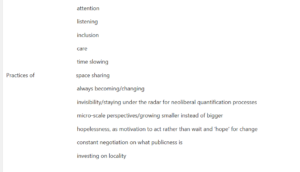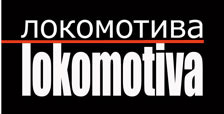- 2016, A LETTER
In 2016, Art Centre BUDA in Belgium celebrated its 10 years with a publication called The Wonderful Workspace of the Future. In it, artists supported by BUDA were asked to write a short text about the future of similar workspaces. I chose to take the suggestion a bit more literally and write an open letter to the future workspaces in 100 years from now:
“How are things there? I mean for the small people?
An open letter to the artistic workspaces of 2016
Dear all, 100 years ago, in January 2016, I entered the kitchen of one of you, called BUDA, around noon. The person who was taking care of our food that day, asked me: ‘How are things in Greece now? I mean for the small people?’. He said he was a small person too. Dear all, in 2016 BUDA was placed in a part of the city called the BUDA island. I imagine that by the moment this letter reaches you, artistic workspaces constitute real islands, separated from the land, safety places accessed from all sides, open ‘gateways leading to this useless confirmation of life’, where small people live.
Dear all, when this letter was written, we worried. About us and about you. We had good reasons to believe that things would not go well. We called this type of thinking ‘dystopian’. At nights, though, we deeply hoped that you would in fact manage better. Especially on the inhabitants of the workspace islands, we counted a lot. We dreamed that the people that come to these islands become immediately small while their magical powers are magnified. That time there counts differently. That one hops on them with an open departure day… when the time comes. We dreamed that the dynamics, complexities, agonisms involved in human encounters are intensified on such islands. We dreamed that they can do magic. And that you still take care of each other’s food. But we would rarely confess such dreams during the day.
Dear all, How are things there? I mean for the small people? If by the time you read this you have found a way to contact us, please let us know. Thank you. A small person in 2016.”
- 2019, A SUMMIT ON ART SPACES AND RESIDENCIES
In the frame of the international summit on art spaces and residencies that took place in Skopje in December 2019, I realized that since my imaginary letter in 2016 my concerns took a much more material turn. I am now interested in the actual passage from the permanent residence of whatever one calls ‘home’ to the temporary home(s) of an art project in the different places that support its development and creation. Under what conditions does a ‘residency’ – as a commonly-used term in artistic production– turn into a work’s residence in the sense of becoming a shelter for it?
The material turn I talk about includes all the words, time, space, human and non-human participants involved in such residency. From the words of the first email exchange to the travel and accommodation arrangements (the time and company of the flight, the living conditions of artists, the food offered there etc), to the intellectual and financial support given to an artwork in a specific frame (feedback dialogues/modes of sharing with local artists, cultural workers of the venue and audience, fees and security frames offered, etc).
In other words, I am interested in the way care (from all those involved, hosts, and invited artists) materializes itself within the practice of residencing, similarly to the way craftsmen work with their materials. I find this shift towards a more material approach to arts (and beyond) very relevant today, in a time when post-fordist immaterial labor has reached ethically challenging limits.
- 2007-2018
Already in 2007, in her text ‘Becoming Room, Becoming Mac’, performance artist Eleanor Bauer writes:
“So we travel very far to make work inside of empty rooms that are not so different from the empty rooms in the city we just left behind: maybe a grey Marley floor instead of a black one, maybe it has a ballet barre, and if we’re lucky it has windows. But how does all that is outside that window change what is made? Or does it only manifest itself in our personal lives? How is one connected to the world while in the room of one’s own? If one puts the Mac of one’s own inside the room of one’s own, one becomes virtually connected way outside the window, but what about just outside the window? Do we care where we work or not? Can we think critically about the relevance of our presence in one place or another? Shall we challenge ourselves to include what is outside the window? Can we take hold of the international network and use it to our advantage instead of running around the globe chasing after the money and space?”
Eleven years later, in 2018, in the book Contemporary Artist Residencies: Reclaiming Time and Space, Pascal Gielen refers to the pressure placed on artists for producing outcomes, for networking and constant visibility, for quantifiable social impact.
From 2007 to 2018, and from the question of the relevance of our presence in a concrete space and time, to the dangerous neoliberal quantification/marketization of art’s impact, there are still many things to discuss and fight for and against.
A relevant question here becomes who benefits from a residency (or any other collaboration between institutions and artists) and why? What are the economy and the powers involved in it?
Why artists leave their home and go somewhere else to work?
- in order to find money to produce their work? (in this case the support by institutions could as well be given in the form of co-production instead of investing on one’s exhausting displacement in order to secure funding for the institution itself)
- because they need the out-of-context quietness of the new place in order to concentrate on their work?
- in order to exchange with other artists in more international or interdisciplinary contexts?
- because the work itself needs for some reason to be there (for example, in the case of interactive projects that need the different social contexts)?
- for some other reason related to the specific context artists visit?
If none of the points 2-5 occur, then maybe it is better to stay at home and re-train ourselves in being part of a community, a skill we keep losing in our constant going around (where you meet many but connect to no-one and no-thing)?
- THE PRACTICE OF RESIDENC-ING…
…as closely related to:

- DISTINCTIONS MATTER
audience development IS NOT building communities
networks ARE NOT communities
charity IS NOT solidarity
The way we name things matters for the way we think and work on them. Frames that may look the same from the outside are the exact opposite in terms of the ethics, aims, and processes involved in them. Especially in the time of post-truth, where everything goes, we have to pay particular attention to what lies behind articulations and be careful with the choice of words and the quality of processes involved in our actions.
- A LIST OF ONGOING QUESTIONS REGARDING RESIDENCES, RESIDENCIES, AND OTHER DWELLINGS
How to dwell a space?
How to co-dwell it?
How to curate a cultural space as space for public exchange?
When does a space become public?
How to co-create public space?
Who needs public space?
Whose public space is it?
What is a region?
What is a locality?
How to create de-centralized cultural spaces in Europe, beyond distinctions between Europe’s ‘centers’ and ‘margins’?
How can the аffect and knowledge produced in initiatives such as the summit on art spaces and residencies in Skopje, be incorporated in the work of the institutions involved?
How can one conceive the material continuation of these initiatives?
Danae Theodoridou is a performance maker and researcher based in Brussels. She studied literature and linguistics in Aristotle University of Thessaloniki (2000) and acting in the National Theatre of Northern Greece (2003). She completed her PhD on dramaturgy of contemporary theatre and dance at Roehampton University in London (2013). In the last five years, her artistic work focuses on the notion of ‘social imaginaries’ and the way art can contribute to the emergence of social and political alternatives. At the same time, Danae has taught in various university departments and art conservatoires of theatre and dance in Europe. Currently, she teaches in the MA Performing Public Space and the BA Dance in Fontys University of Applied Sciences (NL) and in the BA of the Drama Department of Aristotle University of Thessaloniki (GR). She curates practice-led research projects and presents and publishes her research work internationally. She has been the co-creator of Dramaturgy at Work (2013-2016) and the co-author of The Practice of Dramaturgy: Working on Actions in Performance (Valiz, 2017).
For more information: www.danaetheodoridou.com
Art Spaces and Residencies Summit is organised by Lokomotiva – Centre for New Initiatives in Arts and Culture in the framework of the yearly program “Contemporary culture and public policies” 2019, developed as part of the project “Program of Lokomotiva in Kino Kultura – project space for contemporary performing arts and contemporary culture” supported by the City of Skopje, Ministry of Culture of North Macedonia and Centar Municipality and Life Long Burning, programme line Performance situation room supported by Creative Europe.

